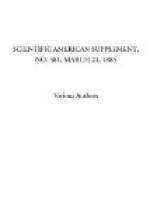(1) According to the first theory, if the impressions which we often find in coal (such as the leaves of Cordaites, bark of Sigillarias and Lepidodendrons, wood of Cordaites, Calamodendrons, etc.) are but simple and superficial mouldings, executed by a peculiar bitumen, formerly fluid, now solidified, and resembling in its properties no other bitumen known, we ought not to find in the interior any trace of preservation or any evidence of structure. Now, upon making preparations that are sufficiently thin to be transparent, from coal apparently formed of impressions of the leaves of Cordaites, we succeed in distinguishing (in a section perpendicular to the limb) the cuticle and the first row of epidermic cells, the vascular bundles that correspond to the veins and the bands of hypodermic libers; but the loose, thin-walled cells of the mesophyllum are not seen, because they have been crushed by pressure, and their walls touch each other. The portions of coal that contain impressions of the bark of Sigillaria and Lepidodendron allow the elongated, suberose tissue characteristic of such bark to be still more clearly seen.
Were we to admit that the bitumen was sufficiently fluid to penetrate all parts of the vegetable debris, as silica and carbonates of lime and iron have done in so many cases, we should meet with one great difficulty. In fact, the number of fragments of coal isolated in schists and sandstone is very large, and without any communication with veins of coal or of bitumen that could have penetrated the vegetable. We cannot, then, for an instant admit such a hypothesis. Neither can we admit that the penetration of the plants by bitumen was effected at a certain distance, and that they have been transported, after the operation, to the places where we now find them, since it is not rare to find at Commentry trunks of Calamodendrons, Anthropitus, and ferns which are still provided with roots from 15 to 30 feet in length, and the carbonized wood of which surrounds a pith that has been replaced by a stony mould. The fragile ligneous cylinder would certainly have been broken during such transportation.
The carbonized specimens were never fluid or pasty, since there are some that have left their impressions with the finest details in the schists and sandstones, but none of the latter that has left its traces upon the coal. The surface of the isolated specimens is well defined, and their separation from the gangue (which has never been penetrated) is of the easiest character.
The facts just pointed out are entirely contrary to the theory of the formation of coal by way of eruption of bitumen.
(2) The place occupied by peats, lignites, and bituminous and anthracite coal in sedimentary grounds, and the organic structure that we find less and less distinct in measure as we pass from one of these combustibles to one more ancient, have given rise to the theory mentioned above, viz., that vegetable matter having, under the prolonged action of heat and moisture, experienced a greater and greater alteration, passed successively through the different states whose composition is indicated in the following table:




